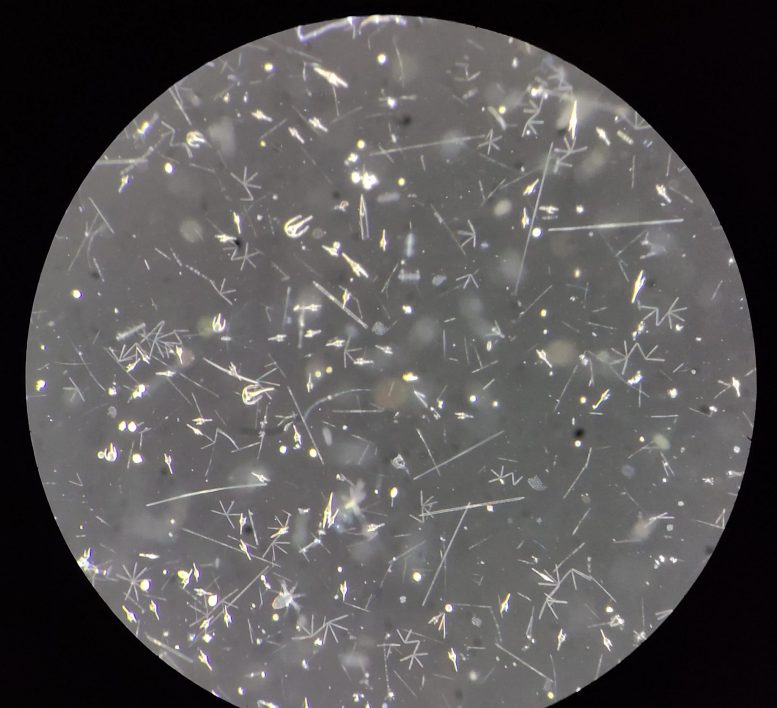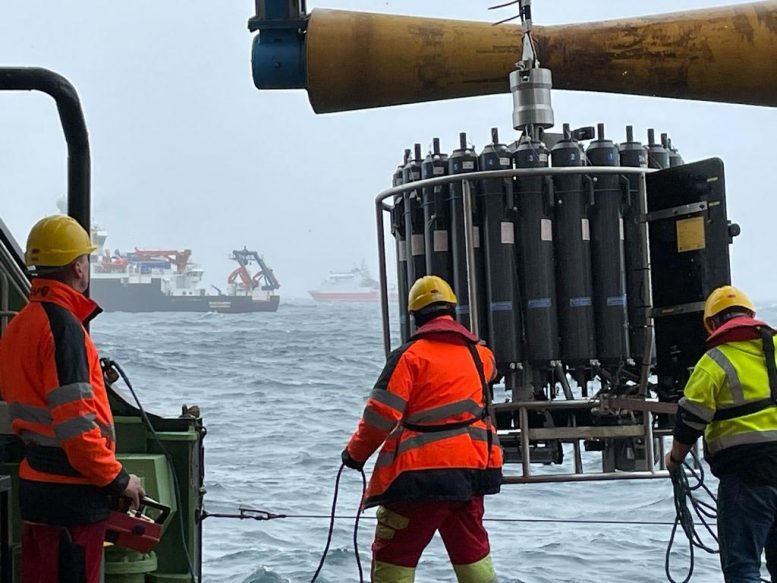Tracking Carbon From the Ocean Surface to the Dark “Twilight Zone”
Different phytoplankton communities bloom around the Canadian Maritime Provinces and across the northwestern Atlantic Ocean. Credit: NASA/Aqua/MODIS composite collected on March 22, 2021
A seaward journey, supported by both NASA and the National Science Foundation, set sail in the northern Atlantic in early May—the sequel to a complementary expedition, co-funded by NSF, that took place in the northern Pacific in 2018.
The 2021 deployment of NASA’s oceanographic field campaign, called Export Processes in the Ocean from Remote Sensing (EXPORTS), consists of 150 scientists and crew from more than 30 governmental, university, and private non-governmental institutions. The team is spread across three oceanographic research vessels, who will meet in international waters west of Ireland over the underwater Porcupine Abyssal plain. Throughout the field campaign, scientists will be deploying a variety of instruments from aboard the three ships: the RRS James Cook and the RRS Discovery, operated by the National Oceanography Centre in Southampton, UK, plus a third vessel chartered by the Ocean Twilight Zone project of the Woods Hole Oceanographic Institution and operated by the Marine Technology Unit in Vigo, Spain. A total of 52 high-tech platforms, including several autonomous vehicles, will be taking measurements and continuously collecting data.

Diverse plankton from surface waters seen under a microscope. It is so concentrated that you don’t need to zoom to identify. Credit: Laura Holland/ University of Rhode Island
Much of the science focuses on the ocean’s role in the global carbon cycle. Through chemical and biological processes, the ocean removes as much carbon from the atmosphere as all plant life on land. Scientists hope to further explore the mechanisms of the ocean’s biological pump—the process by which carbon from the atmosphere and surface ocean is sequestered long-term in the deep ocean. This process involves microscopic plant-like organisms called phytoplankton, which undergo photosynthesis just like plants on land and can be seen from space by observing changes to the color of the ocean. Their productivity has a significant impact on Earth’s carbon cycle, which then in turn affects Earth’s climate.
“This is the first comprehensive study of the ocean’s biological carbon pump since the Joint Global Ocean Flux study in the 1980s and nineties,” said EXPORTS science lead David Siegel from the University of California, Santa Barbara. “In the interim, we have gotten advanced microscopic imaging tools, genomics, robust chemical and optical sensors and autonomous robots—a bunch of stuff that we didn’t have back then, so we can ask much harder and much more important questions.” Those questions include how much organic carbon is leaving the surface ocean, and what path does it take as it makes its way to the deep where it can be sequestered for long periods of time, from decades to thousands of years.

Science and crew aboard the RRS James Cook are deploying a sampling rosette – platform that allows for collection of the water samples and other information from ocean depths, with RRS Discovery and R/V Sarmiento de Gamboa in the distance deploying the same instrumentation simultaneously. Credit: Deborah Steinberg
Scientists know of three major pathways that transport carbon from the atmosphere and upper ocean to the dark “twilight zone” that lies 1,640 feet (500m) or more below the surface: 1) physical ocean mixing and circulation can carry suspended organic matter deep down into the ocean’s interior, 2) particles can sink due to gravity, often after passing through the guts of organisms, and 3) daily vertical migrations of animals that commute between upper and lower ocean levels bring carbon along for the ride.
EXPORTS aims to determine how much carbon is transported by each of these pathways by observing the carbon pump in two very different ocean ecosystems with varying conditions. The researchers chose the northern Pacific and northern Atlantic because they are on the opposite ends of the productivity spectrum (i.e. rates of photosynthesis) and experience two opposing extremes of physical processes such as eddies and currents. Studying contrasting environments will provide the maximum insight for modeling future climate scenarios.

The scientist crew boarded the R/V Sarmiento de Gamboa on April 29 after 14 days in quarantine. Credit: Ken Buesseler/ Woods Hole Oceanographic Institution
According to Ivona Cetinić, project scientist and oceanographer at NASA’s Goddard Space Flight Center in Greenbelt, Maryland, the North Pacific is akin to a desert or “simple meadow” on land. It is low in nutrients, in this case iron needed for photosynthesis, and experiences amongst the fewest eddying currents found in the global oceans. Therefore, carbon transport into the deep ocean is primarily driven by tiny animals, called zooplankton, consuming microscopic plant-like phytoplankton and then excreting the digested carbon to the depths below.
Phytoplankton drift in the upper, sunlit layer of the ocean where they can convert carbon dioxide that comes from the atmosphere into organic carbon. When conditions are right, as is often the case in the North Atlantic region this time of year, phytoplankton populations grow or “bloom” so rapidly they can be seen from space.
The North Atlantic also features strong currents that contrast with the North Pacific’s slower moving waters. Along with those, Siegel says they anticipate at least four days of harsh weather during the month-long expedition.
But EXPORTS data doesn’t just apply to the sea—it will also be used to improve satellite technology. Cetinić works with several optical measurements that come from ocean color satellites, which measure light reflected from the ocean surface in parts of the visible spectrum, what we know as the colors of the rainbow. These provide insights such as measurements of the ocean’s temperature, salinity, carbon, and concentrations of a green pigment called chlorophyll. However, the varying species of phytoplankton occupying different parts of the ecosystem and carbon cycle produce different amounts and shades of green chlorophyll, creating nuance in ocean color that current ocean color satellites can’t “see.”
Among the instrumentation deployed during EXPORTS are highly refined, and in some cases experimental, optical instruments to measure ocean color that are akin to instruments which will be aboard future NASA satellites. Researchers will combine these satellite-simulating measurements with the detailed observations of the surface phytoplankton community—through genomics, image analysis or pigment composition—as well as knowledge of their physiology to enable satellites to detect oceanic diversity and ultimately their role in the oceanic carbon cycle.
The next generation of these satellites, NASA’s Plankton, Aerosol, Cloud, ocean Ecosystem (PACE) mission, will be hyperspectral, meaning it will be able to collect data across the entire visible spectrum, and capture information beyond the visible part, including ultraviolet and shortwave infrared.
“What we see while we are on the ground gives us an understanding of what kind of information we will need to see from space in order to capture those critical processes we want to be able to better understand,” Cetinić said. “That drives the development of the space-based technology. In return, data coming from the new Earth observing satellites allow for scientists, such as the ones participating in EXPORTS, to go and find other crucial information or develop new techniques to complement the current, or even inspire a new, Earth observing satellite. This perpetual interplay of technology and science, ultimately benefits the whole of humanity.”
Following the fieldwork campaign, an additional phase of EXPORTS will focus on using the data collected from the Atlantic and Pacific to predict what the carbon transport pathways may look like in future oceans.
“What we currently know is limited to what is happening in oceans today,” said Siegel. “With the ongoing climate-driven changes, seen not only in the ocean but across the Earth systems, we need to be able to predict what’s going to be happening in 2075, and we do not yet have that predictive understanding.”
Because so many characteristics of a single slice of ocean are going to be measured at the same time, existing computer models will have a rich and more complete data set depicting the carbon pump on which to base projections of what might happen in the near future deeper in the ocean—and what the impacts might be on the carbon cycle.
“It’s such a good data set that it is going to be fueling research for decades to come,” said Cetinić.
Both PACE and EXPORTS experienced delays because of the COVID-19 pandemic. Now, to ensure the safety and security of every individual involved, a two-week quarantine was required before sailing and social distancing protocols were enacted for the first week aboard the ships. Siegel says the diversity and dedication of the team members, the unparalleled support from the U.K.’s National Oceanography Centre to ensure the ships and crew are ready and safe for sailing, the sustained commitment from NASA Headquarters, and a great deal of good fortune is the reason that the campaign is still able to go ahead this year.











 English
English French
French Spanish
Spanish German
German Dutch
Dutch Italian
Italian Danish
Danish Portuguese
Portuguese Greek
Greek Russian
Russian Swedish
Swedish Bulgarian
Bulgarian Hungarian
Hungarian Catalan
Catalan Ukrainian
Ukrainian Polish
Polish Basque
Basque Chinese (Simplified)
Chinese (Simplified) Japanese
Japanese Hebrew
Hebrew Arabic
Arabic Swahili
Swahili Amharic
Amharic Irish
Irish Afrikaans
Afrikaans Albanian
Albanian Armenian
Armenian Azerbaijani
Azerbaijani Belarusian
Belarusian Bengali
Bengali Bosnian
Bosnian Cebuano
Cebuano Chichewa
Chichewa Chinese (Traditional)
Chinese (Traditional) Corsican
Corsican Croatian
Croatian Czech
Czech Esperanto
Esperanto Estonian
Estonian Filipino
Filipino Finnish
Finnish Frisian
Frisian Galician
Galician Georgian
Georgian Gujarati
Gujarati Haitian Creole
Haitian Creole Hausa
Hausa Hawaiian
Hawaiian Hindi
Hindi Hmong
Hmong Icelandic
Icelandic Igbo
Igbo Indonesian
Indonesian Javanese
Javanese Kannada
Kannada Kazakh
Kazakh Khmer
Khmer Korean
Korean Kurdish (Kurmanji)
Kurdish (Kurmanji) Kyrgyz
Kyrgyz Lao
Lao Latin
Latin Latvian
Latvian Lithuanian
Lithuanian Luxembourgish
Luxembourgish Macedonian
Macedonian Malagasy
Malagasy Malay
Malay Malayalam
Malayalam Maltese
Maltese Maori
Maori Marathi
Marathi Mongolian
Mongolian Myanmar (Burmese)
Myanmar (Burmese) Nepali
Nepali Norwegian
Norwegian Pashto
Pashto Persian
Persian Punjabi
Punjabi Romanian
Romanian Samoan
Samoan Scottish Gaelic
Scottish Gaelic Serbian
Serbian Sesotho
Sesotho Shona
Shona Sindhi
Sindhi Sinhala
Sinhala Slovak
Slovak Slovenian
Slovenian Somali
Somali Sundanese
Sundanese Tajik
Tajik Tamil
Tamil Telugu
Telugu Thai
Thai Turkish
Turkish Urdu
Urdu Uzbek
Uzbek Vietnamese
Vietnamese Welsh
Welsh Xhosa
Xhosa Yiddish
Yiddish Yoruba
Yoruba Zulu
Zulu